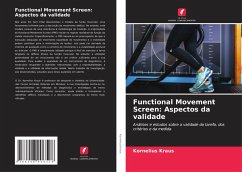
Functional Movement Screen: Aspects of validity
Analyses and studies on task, criteria and measurement validity
Versandkostenfrei!
Versandfertig in 6-10 Tagen
59,99 €
inkl. MwSt.

PAYBACK Punkte
30 °P sammeln!
In the 1950s, Kurt Tittel developed the muscle sling model, a brilliant tool for describing athletic movement. However, this model lacked a reference to measurement methodology. The originality of the Functional Movement Screen (FMS) lies in the practicable recording of muscle chain function. Specifically, the FMS is based on the assumption that adequate execution of movement (movement quality) and mobility can contribute to minimizing injury. This can be derived from assessment criteria such as movement symmetry and postural or joint stability. The FMS is widely used because it is easy to per...
In the 1950s, Kurt Tittel developed the muscle sling model, a brilliant tool for describing athletic movement. However, this model lacked a reference to measurement methodology. The originality of the Functional Movement Screen (FMS) lies in the practicable recording of muscle chain function. Specifically, the FMS is based on the assumption that adequate execution of movement (movement quality) and mobility can contribute to minimizing injury. This can be derived from assessment criteria such as movement symmetry and postural or joint stability. The FMS is widely used because it is easy to perform and makes obvious muscle function deficits tangible. However, the widespread use of a tool is not a sufficient criterion for its quality. In order to evaluate the quality of a diagnostic tool, questions regarding the reproducibility, validity and usefulness of the information obtained must be answered. Solutions to these open questions are developed in this research project.












